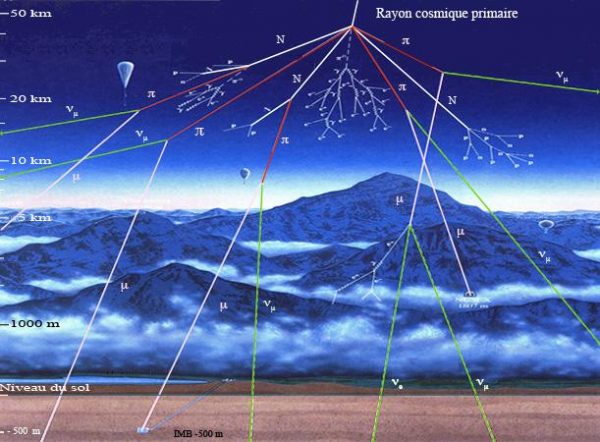Investigating the interior of a pyramid
Using muons coming from space to see through matter
To see through matter, it is Rontgen who first did it, with X-rays. But these rays are stopped with a few centimeters of hard matter (bone, stone…). It is necessary to increase the energy and find radiation more penetrating than X-rays to go further. It is in the cosmic radiation that one can find these rays: the muons.

Cosmic rays are the source of a showers of particles containing muons.
Cosmic radiation coming from space generates in the atmosphere a shower of particles, among them muons which reach the surface of the Earth. Muons are able to pass through tens of meters of rock or earth. They are now used to make this special radiography: a muography.
For more information, see Cosmic rays muons
Analysis of the interior of the Khufu (Kheops) pyramid
This has made it possible to search for hidden cavities in the pyramids. Physicists have thus highlighted in 2017 an unknown cavity in the pyramid of Khufu, by measuring the flux of muons passing through it. New results are about to be published

Muography analysis of the interior of the Khufu pyramid by micromegas detectors developed at CEA in France
For more information, se :
– Evidence of hidden cavities on the great pyramid of Khufu (Kheops)
– ‘Big void’ identified in Khufu’s Great Pyramid at Giza. BBC article
– Documents on pyramids scans (French)
en https://www.laradioactivite.com/site/pages/Documents_ScanPyramids.htm
– Heritage innovation preservation Institute site
Other applications
Other applications of muography are currently developed. For example, to analyse the rock during the drilling of a tunnel.
Imaging can be used to inspect the interior of reactors to be dismantled. Such an approach is being used for the dismantling of two former CEA reactors at Marcoule, shut down in 1983 and 1984. Carried out between February and July 2020 with a small ‘micromega’ telescope, similar to the one used for the pyramid of Kheops, a first image was obtained from muons having passed through the reactor.
The technique is also used to monitor volcanoes. First in Japan. Recently, a project is underway in Italy for the Vesuvius.
For more information, see :
– Analyse the core of an old nuclear reactor to dismantle